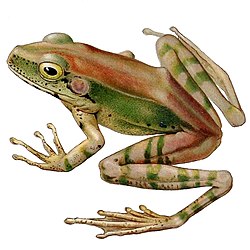| Papurana papua | |
|---|---|
 | |
| Scientific classification | |
| Kingdom: | Animalia |
| Phylum: | Chordata |
| Class: | Amphibia |
| Order: | Anura |
| Family: | Ranidae |
| Genus: | Papurana |
| Species: | P. papua |
| Binomial name | |
| Papurana papua (Lesson, 1830) | |
 | |
| Synonyms [2] | |
| |
Papurana papua is a species of true frog, family Ranidae. [1] [2] It is endemic to New Guinea and found in the northern part of the island in both Indonesia and Papua New Guinea as well in some offshore islands (including Normanby, Waigeo, and Manus Island). [1] [2] [3] Common name Papua frog has been coined for it. [2]
